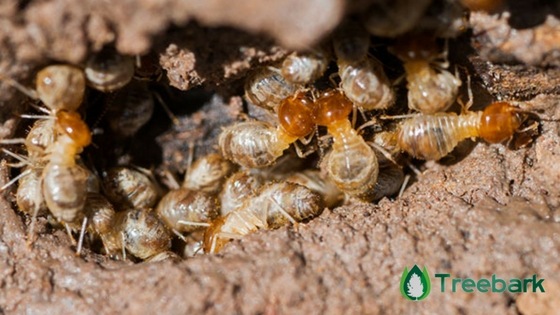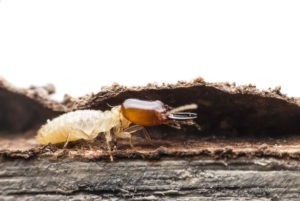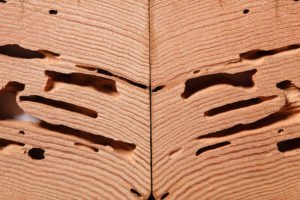
There are many reasons why your home becomes a welcoming abode for white ants or termites. The more you have them, the higher the likelihood to have termites that will chew your house. Damp and dark areas to live as well as abundance of food such as cardboard, papers and untreated wood and wooden products are appealing to these pests.
The biggest factor is the temperature and location of your home. Termites love humid and warm locations for they need it in order to survive. Termites prefer a temperature of 75 degrees Fahrenheit. That’s why states that suffer the most termite damage are those states with warm climates all year round.
During warm summer months, termite activity in the colony will multiply. Each colony is composed of three caste types: the reproductive caste (queen and king, alates or termites with wings and neotenics or heirs), the workers and the soldiers. Depending on the species, the colony sizes would vary. A Formosan colony could have hundreds of thousands while a subterranean colony would have tens of thousands. During summer seasons, termite colonies would greatly expand as workers can forage and bring more food to the colony.
Sure, winter season is still at our door, but we shouldn’t be relaxed. Danger lurks everywhere.
Termite Activity during Winter
Some people actually believe that termites would either die out or go on hibernation this winter season. Wrong! Termites are hardy creatures. Even though they love warm temperatures, they can still live and thrive during freezing temperatures. Most termites, especially subterranean termites and Formosan, would retreat deeper into the ground. These termites require specific moisture and temperature and by digging deeper these requirements are met as they continue to forage for food. There are even recorded reports of termites burrowing 40 inches deeper to the ground during winter.
 Drywood and dampwood termites on the other hand are termite species that live above ground. Thus, during winter season, they retreat not deeper underground but into wooden structures, trees and stumps. Drywood termites would nest inside dry wood while dampwood termites would nest in moist wood to survive. These termites would rarely forage and remain close to the nest during winter.
Drywood and dampwood termites on the other hand are termite species that live above ground. Thus, during winter season, they retreat not deeper underground but into wooden structures, trees and stumps. Drywood termites would nest inside dry wood while dampwood termites would nest in moist wood to survive. These termites would rarely forage and remain close to the nest during winter.
Termite activity would slow down to a certain extent, but they don’t lie dormant. They will still look for food and cause termite damage during winter.
The Lying Danger…
Termites in house are extremely dangerous, even during winter season. There’s a huge chance that termites may end up retreating inside your home rather than deeper into the ground or inside tree stumps. Your home then becomes a huge and comfortable smorgasbord for them.
Actually, our homes are the perfect winter getaway for termites because termites would be able to acquire food, moisture and warmth. With these three things, it would be possible for termites to make it through the season and preserve their entire colony. If a colony is able to infiltrate your home before winter settles in, termite activity would continue unimpeded because they are safeguarded against the cold weather. Thus, the termite damage would be far greater than you ever imagined. By the time you would notice this, it will be too late.
The Termites Signs
The most common sign of termites in home is the presence of swarmers, flying termites or alates. Swarmers would look for a decent place to settle down and start a new colony. However, swarmers don’t appear during winter season. Instead, the signs of termite activity during winter are different. The signs may include:

- Wood Damage – termite infestation always lead to damage wherever they go and it
leads to one of the most common signs of termites, which is wood damage. If there are termites inside your home during winter, you would notice cracks, tiny holes and depressions on wooden surfaces. These are often caused by drywood or dampwood termites. - Hollow sounding wood – termites don’t like open surfaces and prefer the dark and humid environments. Thus, termites would create tunnels and compartments inside walls, floors, ceilings, wooden foundations and furniture that becomes an obvious evidence of termites. An infested wood would sound hollow when you tap it.
- Frass – or termite fecal pellets are the fine powdery and fragile refuse left by drywood termites. Drywood termites are neat freaks. They keep their tunnels clean and create holes to discard their waste. If there are small holes on your walls and furniture, perform a termite inspection and knock it lightly. If there are frass accumulating below or coming out of it, then there are probably termites infesting your home.
- Mud tubes – subterranean and Formosan termites get around your house from their nest by building mud tunnels or termite tubes. These tubes are the size of pens and are made from soil. They are often found protruding from cracks, on the floor, wall and ceilings. When you break them open and see termites, it means there’s an active termite infestation However, if there are no termites, they must have abandoned the nest and moved somewhere else.
Removing the infestation
When it comes to termites, it pays to be vigilant all year round. The best ways to fight termites is to protect your home. If infestation does occur, contact a pest control professional to schedule a termite treatment or termite control service.
